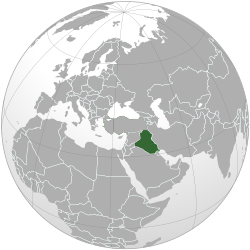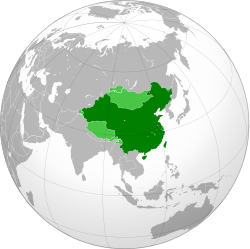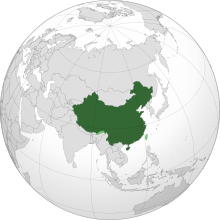User:Shephard 96/sandbox
Mongolian People's Republic[edit]
Mongolian People's Republic Бүгд Найрамдах Монгол Ард Улс Bügd Nairamdakh Mongol Ard Uls | |||||||||
|---|---|---|---|---|---|---|---|---|---|
| 1924–1992 | |||||||||
| Motto: Орон бүрийн пролетари нар нэгдэгтүн! (Oron bürijn proletari nar negdegtün!) «Workers of the world, unite!» | |||||||||
| Anthem: Монгол Интернационал (Mongol Intyernasional) «Mongol International» (1924-1950) Бүгд Найрамдах Монгол Ард Улсын сүлд дуулал (Bugd Nairamdah Mongol Ard Ulsiin süld duulal) «State Anthem of the Mongolian People's Republic» (1950-1991) | |||||||||
 Location of the Mongolian People's Republic during the Cold War. | |||||||||
| Status | Unrecognized state (1924-1946) Satellite state of the Soviet Union (1924-1991) | ||||||||
| Capital and largest city | Ulaanbaatar | ||||||||
| Official languages | Mongolian | ||||||||
| Religion | Atheism (dominant following), Tibetan Buddhism (state religion until 1926, Mongolian shamanism, Christianity, Islam | ||||||||
| Demonym(s) | Mongol, Mongolian | ||||||||
| Government | Unitary one-party socialist republic under a totalitarian dictatorship (1924–1927) Unitary Marxist–Leninist one-party socialist republic (1927–1990)
Unitary semi-presidential republic (1990–1992) | ||||||||
| General Secretary | |||||||||
• 1924–1928 (first) | Tseren-Ochiryn Dambadorj | ||||||||
• 1958–1984 (longest) | Yumjaagiin Tsedenbal | ||||||||
• 1991–1992 (last) | Büdragchaagiin Dash-Yondon | ||||||||
| Head of State | |||||||||
• 1924 (first) | Navaandorjiin Jadambaa | ||||||||
• 1954–1972 (longest) | Jamsrangiin Sambuu | ||||||||
• 1990–1992 (last) | Punsalmaagiin Ochirbat | ||||||||
| Head of Government | |||||||||
• 1924–1928 (first) | Balingiin Tserendorj | ||||||||
• 1952–1974 (longest) | Yumjaagiin Tsedenbal | ||||||||
• 1990–1992 (last) | Dashiin Byambasüren | ||||||||
| Historical era | Interwar period, World War II, Cold War | ||||||||
• Proclamation | 26 November 1924 | ||||||||
| 20 October 1945 | |||||||||
• Independence recognized by Republic of China | 5 January 1946 | ||||||||
• Admitted to United Nations | 25 October 1961 | ||||||||
| 29 June 1990 | |||||||||
| 12 February 1992 | |||||||||
| Area | |||||||||
• Total | 1,564,116 km2 (603,909 sq mi) | ||||||||
| Population | |||||||||
• 1992 estimate | 2,318,000 | ||||||||
| HDI (1992) | 0.560[1] medium | ||||||||
| Currency | Tögrög (MNT) | ||||||||
| Time zone | UTC+7/+8[2] | ||||||||
• Summer (DST) | UTC+8/+9[3] | ||||||||
| Date format | yyyy.mm.dd (CE) | ||||||||
| Driving side | right | ||||||||
| Calling code | +976 | ||||||||
| ISO 3166 code | MN | ||||||||
| |||||||||
| Today part of | Mongolia | ||||||||
Iraqi Republic (1958-1968)[edit]
Iraqi Republic الجمهورية العراقية al-Jumhūrīyah al-'Irāqīyah | |||||||||||
|---|---|---|---|---|---|---|---|---|---|---|---|
| 1958–1968 | |||||||||||
| Anthem: موطني (Mawtini) «My Country» (1958-1965) والله زمان يا سلاحي (Walla Zaman Ya Selahy) «It has been a long time, oh my weapon!» (1965-1968) | |||||||||||
 | |||||||||||
| Capital and largest city | Baghdad | ||||||||||
| Common languages | Arabic, Kurdish | ||||||||||
| Religion | Islam, Christianity, Zoroastrianism, Yazdanism | ||||||||||
| Government | Unitary socialist republic (1958–1964)
Unitary one-party socialist republic under a military dictatorship (1964–1968) | ||||||||||
| President | |||||||||||
• 1958–1963 | Muhammad Najib | ||||||||||
• 1963–1966 | Abdul Salam Arif | ||||||||||
• 1966–1968 | Abdul Rahman Arif | ||||||||||
| Vice President | |||||||||||
• 1963–1964 | Ahmed Hassan al-Bakr | ||||||||||
| Prime Minister | |||||||||||
• 1958–1963 (first) | Abd al-Karim Qasim | ||||||||||
• 1967–1968 (last) | Tahir Yahya | ||||||||||
| Legislature | Revolutionary Command Council | ||||||||||
| Historical era | Cold War | ||||||||||
| July 14, 1958 | |||||||||||
| February 8–10, 1963 | |||||||||||
| February 9, 1963 | |||||||||||
| November 13–18, 1963 | |||||||||||
| July 17, 1968 | |||||||||||
| Area | |||||||||||
| 1968 | 438,317 km2 (169,235 sq mi) | ||||||||||
| Population | |||||||||||
• 1968 | 9,367,100 | ||||||||||
| Currency | Iraqi dinar (IQD) | ||||||||||
| |||||||||||
| Today part of | |||||||||||
Yemen Arab Republic[edit]
Yemen Arab Republic الجمهورية العربية اليمنية al-Jumhūrīyah al-‘Arabīyah al-Yamanīyah | |||||||||
|---|---|---|---|---|---|---|---|---|---|
| 1962–1990 | |||||||||
| Anthem: Peace To The Land (1962-1978) A Nation’s Will (1978-1990) | |||||||||
 | |||||||||
| Capital | Sanaʽa | ||||||||
| Official languages | Arabic | ||||||||
| Religion | Islam, Zaidi, Shia, Sunni | ||||||||
| Government | Unitary parliamentary Islamic republic[4][5] (1962–1982)
Unitary one-party parliamentary Islamic republic under a military dictatorship (1982–1990) | ||||||||
| President | |||||||||
• 1962–1967 (first) | Abdullah as-Sallal | ||||||||
• 1978–1990 (last) | Ali Abdullah Saleh | ||||||||
| Prime Minister | |||||||||
• 1962–1963 (first) | Abdullah as-Sallal | ||||||||
• 1983–1990 (last) | Abdul Aziz Abdul Ghani | ||||||||
| Historical era | Cold War | ||||||||
| 26 September 1962 | |||||||||
| 22 May 1990 | |||||||||
| Currency | North Yemeni rial | ||||||||
| Time zone | UTC+3 | ||||||||
| Calling code | 967 | ||||||||
| |||||||||
| Today part of | |||||||||
Nationalist government (China)[edit]
Republic of China 中華民國 Zhōnghuá Mínguó | |
|---|---|
| 1925–1949 | |
| Anthem: 卿雲歌 (Qīng Yún Gē) «Song to the Auspicious Cloud» (1925–1928) 中華民國國歌 (Zhōnghuá Mínguó guógē) «National Anthem of the Republic of China» (1930–1949) Flag anthem: 中華民國國旗歌 (Zhōnghuá Míngúo Gúoqígē) «National Flag Anthem of the Republic of China» (1937–1949) | |
National seal (1929–1949) | |
 | |
| Capital | Guangzhou (1925-1927; 1949) Wuhan (1927; 1937-1938) Nanking (1927-1937; 1946-1949) Chongqing (1949) Chengtu (1949) |
| Capital-in-exile | Chongqing (1937-1946) |
| Largest city | Shanghai |
| Official languages | Chinese Tibetan Chagatai/Uighur Manchu Mongolian and other languages |
| Government | One-party provisional government (1925–1928) Unitary one-party republic under a authoritarian military dictatorship (1928–1947) Unitary one-party parliamentary constitutional republic under a authoritarian military dictatorship (1947–1949) |
| Chairman | |
• 1928 | Tan Yankai |
• 1928–1931 | Chiang Kai-shek |
• 1931–1943 | Lin Sen |
• 1943–1949 | Chiang Kai-shek |
• 1949 | Li Zongren |
| Premier | |
• 1928–1930 (first) | Tan Yankai |
• 1949 (last) | Yan Xishan |
| Historical era | Interwar Period, World War II, Cold War |
• Established | July 1, 1925 |
| 1926–1928 | |
• Reset in Nanking | April 18, 1927 |
| 1927–1936, 1946–1950 | |
| July 7, 1937-September 2, 1945 | |
| October 24, 1945 | |
| October 25, 1945 | |
| February 28, 947 | |
| December 25, 1947 | |
| October 1, 1949 | |
• Dissolution | December 7, 1949 1949 |
| Currency | Chinese yuan Old Taiwan dollar (1946–1949 in Taiwan) |
Wang Jingwei regime[edit]
Republic of China 中華民國 Zhōnghuá Mínguó Chūka Minkoku | |||||||||||||||
|---|---|---|---|---|---|---|---|---|---|---|---|---|---|---|---|
| 1940–1945 | |||||||||||||||
| Motto: 和平反共建國 (Hépíng fǎngòng jiànguó) «Peace, Anti-Communism, National Construction» | |||||||||||||||
| Anthem: 中華民國國歌 (Zhōnghuá Mínguó guógē) «National Anthem of the Republic of China» | |||||||||||||||
 The Wang Jingwei regime (dark red) and Menchiang (light red) within the Empire of Japan (pink) at its furthest extent | |||||||||||||||
| Status | Puppet state of the Empire of Japan | ||||||||||||||
| Capital | Nanking | ||||||||||||||
| Largest city | Shanghai | ||||||||||||||
| Official languages | Mandarin Japanese | ||||||||||||||
| Government | Unitary one-party republic under a authoritarian military dictatorship | ||||||||||||||
| President | |||||||||||||||
• 1940–1944 | Wang Jingwei | ||||||||||||||
• 1944–1945 | Chen Gongbo | ||||||||||||||
| Vice President | |||||||||||||||
• 1940–1945 | Zhou Fohai | ||||||||||||||
| Historical era | World War II | ||||||||||||||
• Established | March 30, 1940 | ||||||||||||||
• Recognized by Japan | November 20, 1940 | ||||||||||||||
• Death of Wang Jingwei | November 10, 1944 | ||||||||||||||
| August 15, 1945 | |||||||||||||||
• Dissolution | August 16, 1945 | ||||||||||||||
| |||||||||||||||
| Today part of | |||||||||||||||
People's Republic of China (1949–1976)[edit]
People's Republic of China 中華人民共和國 Zhōnghuá Rénmín Gònghéguó | |||||||||||||||
|---|---|---|---|---|---|---|---|---|---|---|---|---|---|---|---|
| 1949–1976 | |||||||||||||||
| Anthem: 義勇軍進行曲 (Yìyǒngjūn Jìnxíngqǔ) «March of the Volunteers» 東方紅 (Dōngfāng Hóng) «The East Is Red» (1966–1969, de facto) | |||||||||||||||
National Seal: 1949–1959 | |||||||||||||||
 Land controlled by the People's Republic of China shown in dark green; land claimed but not controlled shown in light green. | |||||||||||||||
| Capital | Beijing | ||||||||||||||
| Largest city | Shanghai | ||||||||||||||
| Official languages | Standard Chinese | ||||||||||||||
| Recognised regional languages | |||||||||||||||
| Official script | Traditional Chinese Simplified Chinese[a] | ||||||||||||||
| Ethnic groups | See Ethnic groups in China | ||||||||||||||
| Religion | See Religion in China | ||||||||||||||
| Demonym(s) | Chinese | ||||||||||||||
| Government | Unitary Marxist–Leninist one-party socialist republic under a Maoist autocratic totalitarian dictatorship | ||||||||||||||
| General Secretary | |||||||||||||||
• 1949–1976 | Mao Zedong | ||||||||||||||
| Chairman | |||||||||||||||
• 1949–1959 | Mao Zedong | ||||||||||||||
• 1959–1968 | Liu Shaoqi | ||||||||||||||
• 1968–1972 | Soong Ching-ling | ||||||||||||||
• 1972–1975 | Dong Biwu | ||||||||||||||
• 1975–1976 | Zhu De | ||||||||||||||
| Premier | |||||||||||||||
• 1949–1976 | Zhou Enlai | ||||||||||||||
• 1976 | Hua Guofeng | ||||||||||||||
| Legislature | Chinese People's Political Consultative Conference (1949-1954) National People's Congress (1954–1976) | ||||||||||||||
| Historical era | Cold War | ||||||||||||||
| October 1, 1949 | |||||||||||||||
| May, 1950 | |||||||||||||||
| 1950–1953 | |||||||||||||||
| 1958–1962 | |||||||||||||||
| 1966–1976 | |||||||||||||||
| September 9, 1976 | |||||||||||||||
| Area | |||||||||||||||
• Total | 9,596,961 km2 (3,705,407 sq mi) | ||||||||||||||
| Population | |||||||||||||||
• 1950 | 554,419,273 | ||||||||||||||
• 1975 | 926,240,885 | ||||||||||||||
| Currency | Renminbi (yuan; ¥) (CNY) | ||||||||||||||
| Time zone | UTC+8 (China Standard Time) | ||||||||||||||
| Date format | |||||||||||||||
| Calling code | +86 | ||||||||||||||
| |||||||||||||||
All references[edit]
- ^ "Human Development Report 1992" (PDF). hdr.undp.org.
- ^ "Mongolia Standard Time is GMT (UTC) +8, some areas of Mongolia use GMT (UTC) +7". Time Temperature.com. Archived from the original on October 13, 2007. Retrieved September 30, 2007.
- ^ "Clock changes in Ulaanbaatar, Mongolia". timeanddate.com. Archived from the original on March 25, 2015. Retrieved March 27, 2015.
- ^ "Constitution of the Yemen Arab Republic, 1970". al-bab.com. Retrieved 8 February 2018.
- ^ Bühler, Konrad G. (8 February 2001). State Succession and Membership in International Organizations. ISBN 9041115536. Retrieved 13 February 2018.
{{cite book}}:|website=ignored (help) - ^ General Information of the People's Republic of China (PRC): Languages, chinatoday.com, retrieved 17 April 2008
Cite error: There are <ref group=lower-alpha> tags or {{efn}} templates on this page, but the references will not show without a {{reflist|group=lower-alpha}} template or {{notelist}} template (see the help page).











